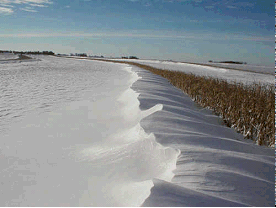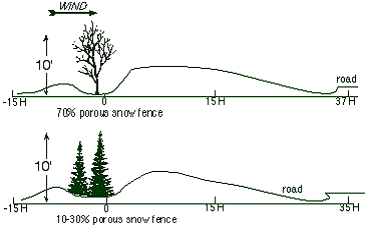Section 2: Snow Fences
Anchor: #i1001002Preventing Snow from Drifting onto Highways
The primary purpose of a snow fence is to prevent the problems of snow drifting onto highways. Many of the drifting problems occur in the same place year after year. The use of strategically placed snow fences can help.
Anchor: #i1001012Where Effective
Snow fences have proven to be cost effective in many areas of the country that receive large amounts of snowfall. While they have been used effectively in Texas, they are used sparingly due to lower annual snowfall amounts.
Anchor: #i1001022Varieties and Forms
Snow fences come in many different varieties and forms. There are the traditional wood fences, high-density polypropylene fabric, extruded polyethylene and even living snow fences. Living snow fences are designed plantings of trees and/or shrubs and native grasses located along roads or around communities and farmsteads. Properly designed and placed, these living barriers trap snow as it blows across fields, piling it up before it reaches a road, waterway, farmstead or community.
Figure 9-1. Living Snow Fence, courtesy University of Minnesota and Minnesota DOT.
Figure 9-2. Wood Fence, courtesy University of Minnesota and Minnesota DOT.
Figure 9-3. Snow fence density and height control snow deposition distance. The more porous the snow fence, the longer the deposition distance.

